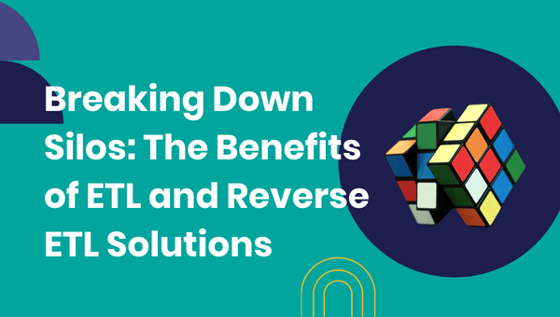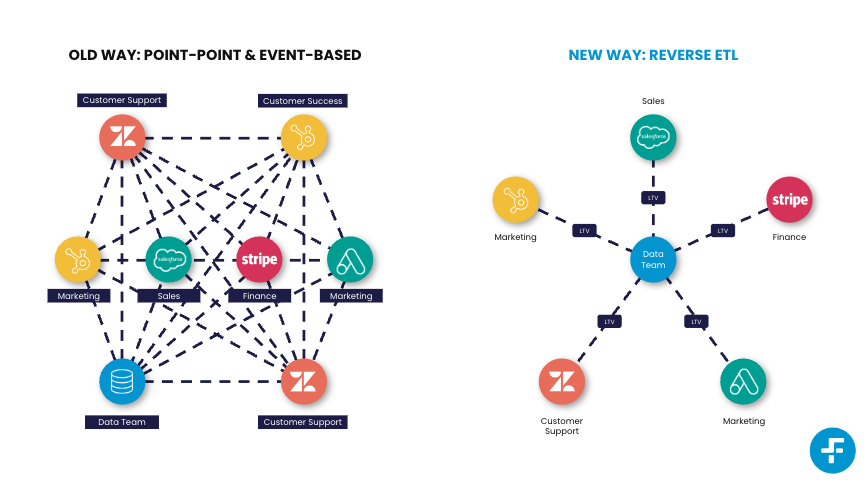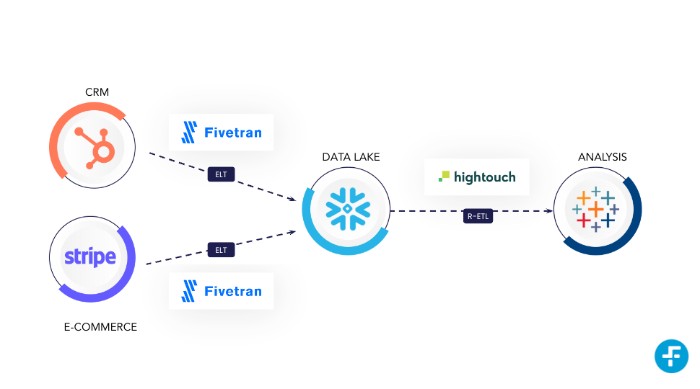


Breaking Down Silos: The Benefits of ETL and Reverse ETL Solutions




Imagine walking into a room where everyone speaks a different language. The noise and confusion can quickly become overwhelming. We can apply this analogy to data within a business. Without the proper tools to extract, transform, and load data from various systems into a centralised format, data can become fragmented and difficult to manage. In essence, your data would be speaking different languages.
There are many reasons why silos form in businesses. It could be because different departments have different goals and objectives or use other technologies. Whatever the reason, silos can cause inefficiencies and duplication of effort... And, it's ultimately the customer that is impacted.
This is where ETL (extract, transform, load) and Reverse ETL solutions come into play. By translating the technology to speak the same language, these solutions allow businesses to create a single source of truth, making it easier to understand customer interactions and drive growth.
Data Silos and the Problem with Point-to-Point Integration
Data silos and the challenges they pose
Data silos are a common issue that businesses face when it comes to managing their data. Often, it occurs when teams use cobbled systems and data is isolated to individual platforms. But, we also see it in platforms that built from acquisition.
This creates several challenges...
A lack of coherent data
Data trapped within silos can quickly become outdated, inconsistent, or simply inaccurate, hindering decision-making processes and creating operational inefficiencies.
Limited insight into business performance
With data silos hindering a comprehensive view of all relevant information, it becomes nearly impossible to fully understand a business's performance and determine areas for improvement. Teams become isolated, working with their own data sets and lacking access to the information they need to make informed decisions. This can lead to conflicting objectives and a subpar customer experience.
Isolated teams
Data silos have the potential to breed an environment of isolation and miscommunication, with different departments or business units working in silos, hoarding their data from one another.
No centralised data governance
Siloed data can also result in a lack of central authority over data definitions, leading to confusion and a host of inconsistencies that can be difficult to manage.
Compromised data security
When different departments or business units maintain their own data, each with its own security protocols and access controls, the risk of data breaches or unauthorised access to sensitive information increases.
Point-to-point integration and its limitations

The traditional way of integrating data between systems is through point-to-point integration. This involves connecting two systems, typically with an event-based integration. While this method can be effective in some cases, it has several limitations:
Complexity
As the number of systems being integrated increases, the complexity of the integration increases, making it more difficult to manage.
Inefficiency
Point-to-point integration can lead to data being duplicated across multiple systems, which can be inefficient and lead to errors.
Data silos
Because each integration is separate, this can create additional data silos, making it even harder to manage the data and gain meaningful insights from it.
The need for a centralised approach to data integration
To overcome the challenges posed by data silos and point-to-point integration, businesses need a centralised approach to data integration. This involves extracting data from multiple systems, transforming it into a consistent format, and loading it into a centralised data repository, such as a data lake. With a centralised approach, businesses can gain a comprehensive view of their data and use it better to drive growth and success. Businesses can deliver best-in-class customer experiences.
We advise our clients to leverage platforms such as Fivetran & HubSpot to achieve a holistic view of their customers. The process may look something like...

Using Fivetran to Extract and Load Data
Fivetran is a cloud-based data integration platform that automates the process of extracting, and loading data from various sources into a centralised data warehouse. With Fivetran, you can get a clear and complete picture of your business data, streamline decision-making, and drive growth.
Fivetran in Action: Extract, Transform, Load (ETL) and Reverse ETL
Fivetran does the heavy lifting for you by extracting data from disparate sources, transforming it into a consistent format, and loading it into your data warehouse. And with Reverse ETL, Fivetran can also replicate data from your data warehouse back to your source systems, so you can keep data updated in real time.
Using Fivetran, you'll enjoy a range of benefits, including increased data accuracy, better data security, and faster data integration. Fivetran eliminates the need for manual data integration, freeing up your time to focus on more strategic initiatives. With Fivetran, you can break down data silos, improve collaboration, and drive business growth.







